|
WASSILY KANDINSKY by Amit Varma
|
Wassily Kandinsky (or, in complete Russian, Vasily Vasilyevich
Kandinsky), was born in Moscow on December 4th, 1866
and has been hailed as one of the fathers of abstract art. Kandinsky's
parents took much interest in music and so their influence led
him to learn to play the piano and cello at an early age. And
for this reason music has heavily influenced his paintings,
especially the titles of his paintings "Improvisations", "Impressions",
and "Compositions." His parents divorced when he was 5 and he
lived with his father and aunt in Odessa (Ukraine), first painting
in oils at age 13. At the age of
20, he attended the University
of Moscow where he studied law and economics and then
later taught at the Moscow Faculty of Law. Several years
later, he attended a French Impressionist exhibition where Monet's
"Haystacks at Giverny" sparked Kandinsky's interest in
the impressionist art form. At the age of 30, Kandinsky went
Munich to study sketching and anatomy, which provided for his
foundation in art. He began writing criticism and color theory
in 1904, and separated from his wife to enter exhibitions and
travel throughout Europe and Africa with his lover, the talented
art student Gabriele
Münter. Years later,
his abstract art form surpassed that of the impressionist and
he became known as the father of "abstract" art. When
commenting on his art work, Kandinsky said " ...I applied
streaks and blobs of colors onto the canvas with a palette knife
and I made them sing with all the intensity I could... "
|
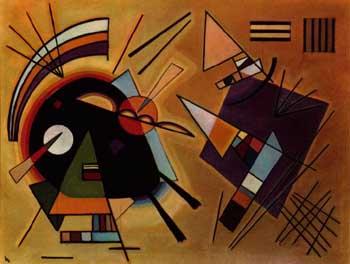 Black And Violet, 1923
Black And Violet, 1923 |
From 1903 onward, Kandinsky's art was exhibited
throughout Europe but caused much controversy among the public
and art critics. Kandinsky heavily influenced some of the 20th
century art movements and became co-founder of the Blue Rider
or Der
Blaue Reiter. The Blue Rider movement was mostly made
up of German artists and was the main point in German Expressionism
but it also opened the doors for free spirit and originality
in painting. Kandinsky's Improvisations became the first
"abstract" pictures and allowed for the Blue Rider movement
to begin. His first work in this mode was completed in 1910,
the year in which he wrote an important theoretical study, Concerning
the Spiritual in Art. In this work he examines the psychological
effects of color with analogies between music and art. In 1914
Kandinsky returned to Russia where he stayed until 1921. In
1922 he came back to Germany to teach and work at the Bauhaus
in Dessau until 1933. At the Bauhaus, Kandinsky had his most
productive and prolific time but in 1933, when the German Nazis
came to power, all modern art was considered as degenerated
art and the Bauhaus was closed. Kandinsky's works were removed
from German museums and confiscated. Kandinsky then moved to
Neuilly near Paris where he remained and continued painting
until his death in December 1944. Overall Kandinsky developed
his own style that was expressive and colorful and he helped
develop the expressionist form of painting.
|
|
Kandinsky developed his idea of the correspondence
between a work of art and the viewer, and called it "Klang"
(sound or resonance). His famous quote accurately describes
his appreciation for both music and art: "Color is the power
which directly influences the soul. Color is the keyboard, the
eyes are the hammers, the soul is the piano with the strings.
The artist is the hand which plays, touching one key or another,
to cause vibrations in the soul." During Kandinsky's period
of artistic development, he divided his paintings into three
main categories: "Impressions" (which still show some representational
elements), "Improvisations" (which convey spontaneous emotional
reactions), and "Compositions" (which are his ultimate works
of art, and he created them after much preparation thus throughout
his life he completed only 10 "Compositions").
|
|
The "Compositions" are by far the most famous
pieces by Kandinsky as they were his ultimate pieces of artwork.
His first three compositions were destroyed during the beginning
of World War II, yet the others remain and are considered his
best work.
"Composition IV is depicted with various
parts of swirling colors and soaring lines. The painting is
divided abruptly in the center by two thick, black vertical
lines. On the left, a violent motion is expressed through the
profusion of sharp, jagged and entangled lines. On the right,
all is calm, with sweeping forms and color harmonies (Harden)."
|
|
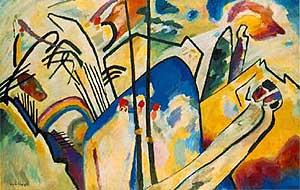
Composition IV
|
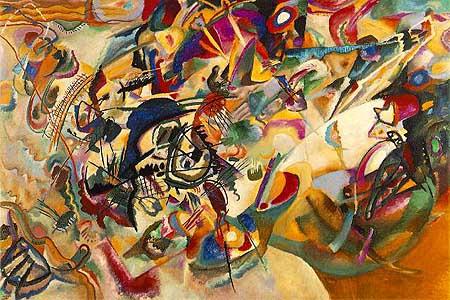 Composition VII
Composition VII |
|
However, Composition VII is arguably his
most famous art piece as it finally gave rise to Kandinsky and
his truly abstract art form. The creation of this composition
included over thirty preparatory drawings, watercolors and oil
studies. These document the deliberate creative process used by
Kandinsky in his compositions. However, once Kandinsky had completed
the preparatory work, he did the actual painting of Composition
VII in less than four days. Art scholars, through Kandinsky's
writings and study of the less abstract preparatory works, have
determined that Composition VII combines the themes of The
Resurrection, The Last Judgment, The Deluge and The Garden
of Love in an operatic outburst of pure painting (Harden).
|
Improvisation 31 is another one of
Kandinsky's more famous pieces was painted in 1913 and is currently
showcased in Washington DC at the National
Gallery of Art.
|
|
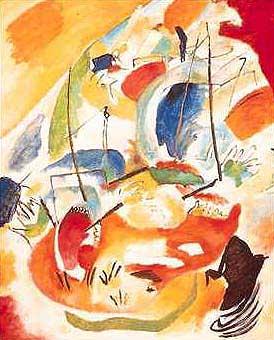 Improvisation 31 (Sea Battle)
Improvisation 31 (Sea Battle)
|
Kandinsky's unrelenting quest for new forms has carried
him to the very extremes of geometric abstraction and has provided us
with an unparalleled collection of abstract art.
Kandinsky is truly the father of non-representational painting.
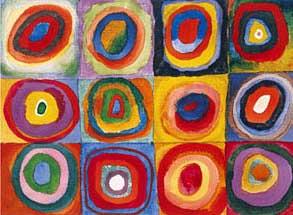
Farbstudie Quadrate Mit Konzentrischen Ringen
(or Squares with Concentric Rings)
WORKS CITED
http://www.glyphs.com/art/kandinsky/ (Mark
Harden, Senior Art Editor's website)
http://www.oir.ucf.edu/wm/paint/auth/kandinsky/
http://www.ibiblio.org/wm/paint/tl/20th/abstract.html
|




